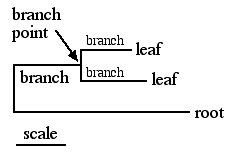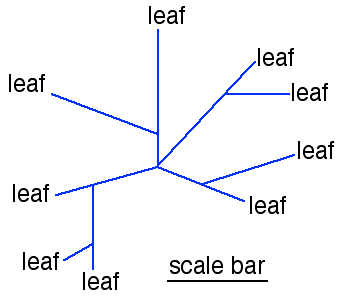
Phylogenetic trees are designed to reveal evolutionary relationships among DNA or protein sequences. The use of the term "tree" has given rise to arborial terminology to describe the different parts of the overall tree. In order to depict related sequences on a rooted tree, the investigator must know one sequence is very distantly related to all the others. This most distant sequence is used to root the tree.

Figure 1. This figure illustrates the most common terminology for phylogenetic trees: root, branch, branch point and leaf. Though there are variations of these terms which you may encounter in other readings, the ones illustrated here are widely used..
When the investigator has not included one distantly related sequence for comparison, then an unrooted tree is required. Since the visual display of the unrooted tree is very different, it might be beneficial to choose an unrooted tree to depcit clusters of related sequences.

Figure 2. In this unrooted tree, the branches are blue and the leaves are labeled as such.
© Copyright 2001 Department of Biology, Davidson College, Davidson, NC 28036
Send comments, questions, and suggestions to: macampbell@davidson.edu